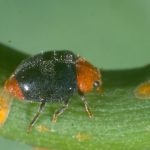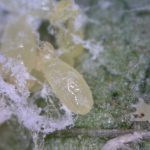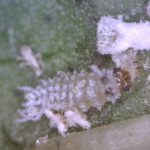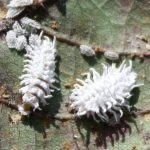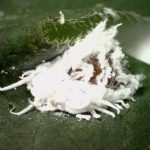Cryptolaemus montrouzieri is a ladybird beetle native to Australia that feeds predominately on mealybug and soft scale insects. Identified as an effective biological control agent, it has been exported to many other regions, and is reared commercially for control of a range of mealybug species, particularly in horticultural crops.
- Adult Cryptolaemus are small ladybeetles around 6 mm in length (photo by Joe Wessels)
- Small, cream coloured eggs are often laid in clusters in a concealed location and covered with scales (photo by Jamie Hopkinson)
- Early instar larva of Cryptolaemus (photo by Tonia Grundy)
- Late instar larvae of Cryptolaemus (photo by Zara Hall)
- Cryptolaemus pupa (photo by Tonia Grundy)
In cotton crops where solenopsis mealybug (Phenacoccus solenopsis) is present, Cryptolaemus contributes to the natural enemy complex that plays a critical role in the control of this pest. Usually it occurs in lower numbers than other species that prey on solenopsis (such as three-banded ladybirds, green lacewings and the parasitoid Aenasius bambawalei).
So just how voracious is the mealybug destroyer against solenopsis?
Recent Department of Agriculture and Fisheries (DAF) research examined Cryptolaemus development and larval consumption of solenopsis mealybug under laboratory conditions. We found that in just over two weeks, an average of 783 mealybugs were consumed per larvae during their 4 instar stages (Figure 1).
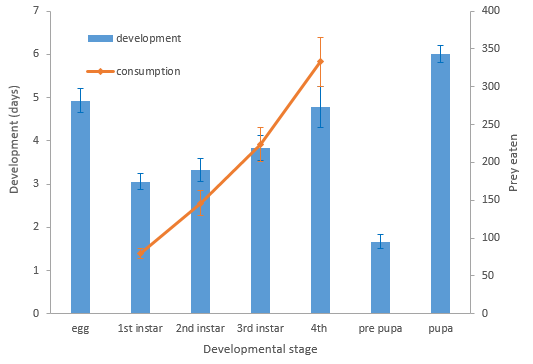
Figure 1. Cryptolaemus development and prey consumption. Total juvenile development averaged 26 days at 25 °C, larval instar development averaged 15 days.
At nearly 80 solenopsis mealybug per day, Cryptolaemus certainly earn their ‘destroyer’ moniker, but the assistance they and other natural enemies render to mealybug management is reliant on an IPM-friendly approach to pest management:
- Practice good farm hygiene and avoid crop stress
- Monitor for beneficials as well as pests
- Utilise thresholds when making management decisions
- Avoid products toxic to natural enemies, particularly early in the season
Further information
- Cryptolaemus (mealybug ladybird) at the Business Queensland website.
- Refer to the latest Cotton Pest Management Guide (available on the CottonInfo website) for more information about solenopsis mealybug management, and the impact of insecticides on ladybird beetles in cotton.
- Cryptolaemus are commercially produced in Australia. They are unlikely to be economically viable for large scale innundative release in field crops, but under some circumstances may have potential to assist with mealybug control if released with other biocontrol agents into ‘hotspots’ in younger cotton crops.
This research has been supported by the Cotton Research and Development Corporation (CRDC) through the project Mirid and mealybug best practice management (DAQ1802).

